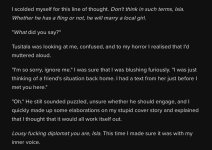ElectricBlue
Joined 11 Years Ago
- Joined
- May 10, 2014
- Posts
- 18,912
In this style, you dispense entirely with quotes, inner dialogue tags, etc. You just narrate Todd's thoughts. This is my favorite way to do this..
I'm with Simon and Melissa. Keep it simple, and use context to make it clear what's a thought and what's narrative.That's exactly what I do. On occasion, if it comes off clunky, or seems repetitious, I will write "Yada yada yada," she muttered or something like that to break it up.
I use close third person a lot, and if the narrator is right in close to a character, they're alongside side the thought anyway, so you don't need use formats to signify. Context does it just fine.
